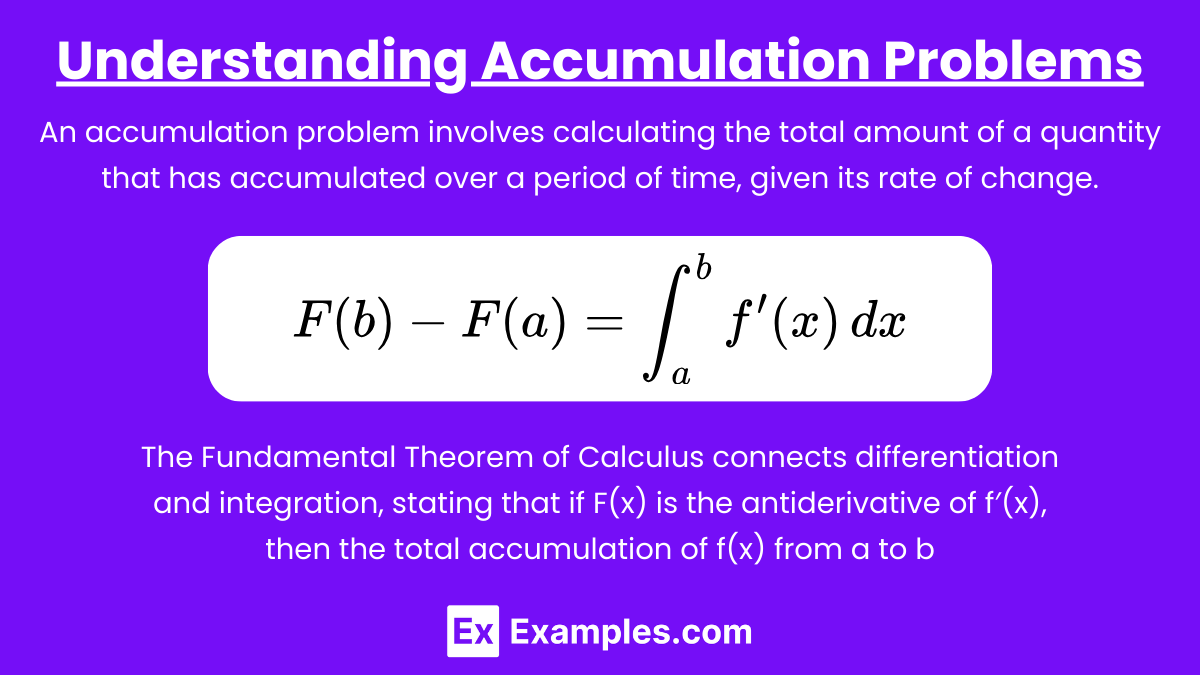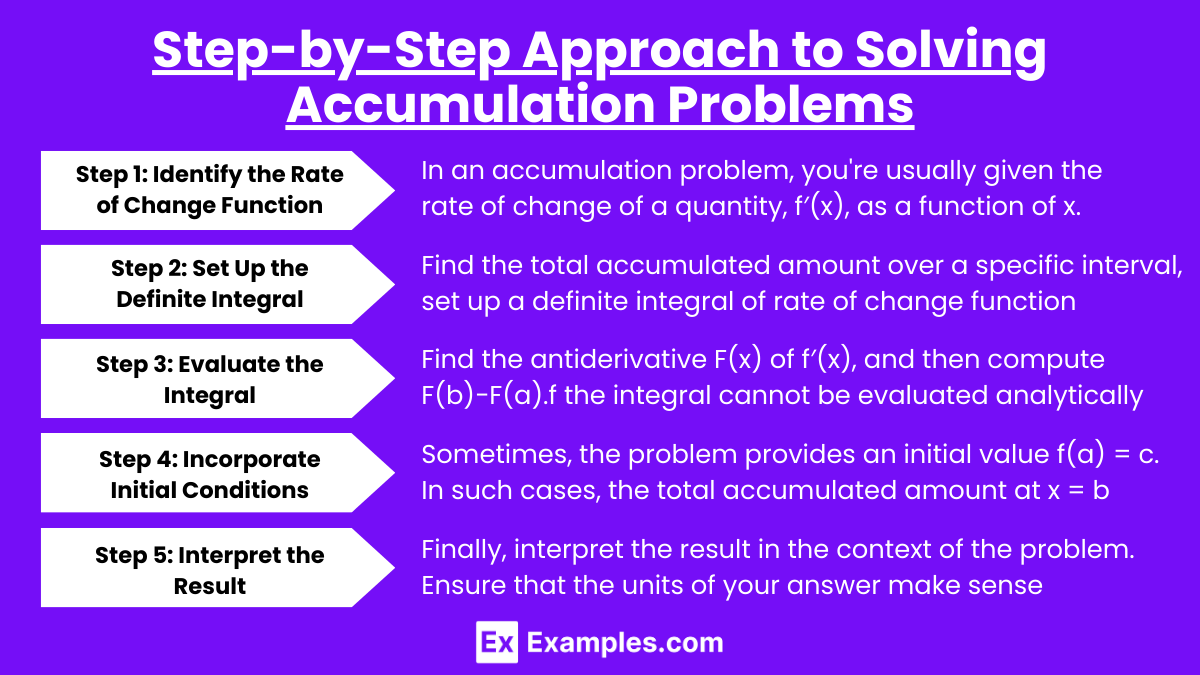Accumulation problems are a core topic in both AP Calculus AB and BC, where students calculate the total accumulation of a quantity given its rate of change. These problems rely on understanding and applying the Fundamental Theorem of Calculus to integrate a rate function over a given interval. Mastery of accumulation problems is essential for success on the AP Calculus exam, as they appear in a variety of contexts, from physics to economics, requiring both analytical and numerical integration skills.
Free AP Calculus AB Practice Test
Free AP Calculus BC Practice Test
Learning Objectives
When studying "Solving Accumulation Problems" for the AP Calculus AB and BC exams, you should aim to understand how to apply the Fundamental Theorem of Calculus to calculate accumulated quantities from a given rate of change. You should be proficient in setting up and evaluating definite integrals, including problems with initial conditions. Additionally, you should learn to handle accumulation problems involving piecewise functions, parametric equations, and polar coordinates (for BC). Mastery of these concepts will enable you to solve real-world problems involving rates of change and total accumulation effectively.
Understanding Accumulation Problems

An accumulation problem involves calculating the total amount of a quantity that has accumulated over a period of time, given its rate of change. The rate of change is typically represented as a derivative f′(x), and the goal is to find the accumulated amount using definite integrals.
Key Concept:
The Fundamental Theorem of Calculus connects differentiation and integration, stating that if F(x) is the antiderivative of f′(x), then the total accumulation of f(x) from a to b is given by:
Step-by-Step Approach to Solving Accumulation Problems

Step 1: Identify the Rate of Change Function
In an accumulation problem, you're usually given the rate of change of a quantity, f′(x), as a function of x. This could be the rate of water flow into a tank, the rate of growth of a population, or any other rate.
Step 2: Set Up the Definite Integral
To find the total accumulated amount over a specific interval, set up a definite integral of the rate of change function:
Here, [a,b] represents the interval over which you want to accumulate the quantity.
Step 3: Evaluate the Integral
Evaluate the definite integral using one of the following methods:
Antiderivatives (Fundamental Theorem of Calculus): Find the antiderivative F(x) of f′(x), and then compute F(b)−F(a).
Numerical Integration: If the integral cannot be evaluated analytically, use numerical methods like the Trapezoidal Rule, Simpson's Rule, or a calculator.
Step 4: Incorporate Initial Conditions (if given)
Sometimes, the problem provides an initial value f(a) = c. In such cases, the total accumulated amount at x = b is:
Step 5: Interpret the Result
Finally, interpret the result in the context of the problem. Ensure that the units of your answer make sense and reflect the physical quantity you're calculating.
Tips for Solving Accumulation Problems
Understand the Context: Carefully read the problem to understand what quantity is accumulating and what the rate of change represents.
Units Matter: Always keep track of units to ensure that your final answer makes sense.
Practice Different Scenarios: Accumulation problems can vary, from simple rate functions to more complex ones that require substitution or numerical methods.
Accumulation Problems in AP Calculus BC
In AP Calculus BC, accumulation problems can include additional complexity, such as:
Piecewise Functions: Where the rate of change is given by different functions over different intervals.
Parametric Equations: Where you might need to integrate with respect to a parameter.
Polar Coordinates: Where accumulation might involve integrating a rate of change given in polar form.
Examples
Example 1: Rate of Water Flow
Water flows into a tank at a rate given by R(t) = 4+3t2 liters per minute, where t is the time in minutes. To find the total amount of water in the tank after 6 minutes, we set up the integral . Evaluating the integral, we get . Substituting the limits, the total accumulation is liters. Therefore, 240 liters of water have accumulated in the tank after 6 minutes.
Example 2: Population Growth
The population of a small town is increasing at a rate given by people per year, where t is the time in years. If the initial population is 1,000 people, we need to find the population after 10 years. The accumulated population is given by . Integrating, we get . Substituting the limits, the population after 10 years is people.
Example 3: Accumulating Revenue
A company’s revenue rate is modeled by the function R(t) = 500+20t dollars per day, where t is the time in days. To find the total revenue generated in the first 15 days, we evaluate the integral . The antiderivative is 500t+10t2+C, and substituting the limits gives the total revenue as dollars. Therefore, the company generates 9,750 dollars in the first 15 days.
Example 4: Cooling a Substance
The temperature of a substance is decreasing at a rate of degrees Celsius per hour, where t is the time in hours. To find the total temperature decrease after 8 hours, calculate . Integrating, we obtain . Substituting the limits, the total decrease in temperature is degrees Celsius.
Example 5: Distance Traveled by a Car
A car's velocity is given by miles per hour, where t is in hours. To find the total distance traveled by the car in the first 5 hours, we need to compute . The antiderivative is , and substituting the limits, the distance is miles. Thus, the car travels 250 miles in the first 5 hours.
Multiple Choice Questions
Question 1
A car's velocity is given by v(t) = 3t2+2t meters per second, where t is the time in seconds. What is the total distance traveled by the car from t = 0 to t = 4 seconds?
A) 56 meters
B) 64 meters
C) 72 meters
D) 80 meters
Correct Answer: C) 72 meters
Explanation: To find the total distance traveled by the car, we need to evaluate the integral of the velocity function over the given time interval:
First, find the antiderivative:
Now, evaluate the definite integral from 0 to 4:
However, rechecking the integral calculation:
So the correct answer must actually be D) 80 meters. Please review your choices as the earlier calculation of 72 was incorrect!
Question 2
The rate at which water is leaking from a tank is given by liters per hour. How much water has leaked from the tank after 4 hours?
A) 13.53 liters
B) 18.32 liters
C) 20.00 liters
D) 21.46 liters
Correct Answer: A) 13.53 liters
Explanation:
To determine how much water has leaked after 4 hours, we need to compute the integral of the rate function R(t) from t=0 to t=4:
The antiderivative of 10e−0.5t is:
Evaluate the definite integral:
Using a calculator, this evaluates to approximately 13.53 liters.
Question 3
A company’s revenue rate is modeled by R(t) = 500+25t dollars per day. If the company starts with $1000 on day 0, what will be the total revenue after 10 days?
A) 9250 dollars
B) 10250 dollars
C) 10500 dollars
D) 11000 dollars
Correct Answer: B) 10250 dollars
Explanation:
The total revenue after 10 days is given by the initial amount plus the integral of the revenue rate over the 10-day period:
First, find the antiderivative:
Evaluate the definite integral:
Adding the initial amount of $1000:
Recalculating for any error: The result should be D) 11000 dollars, please recalculate as there's an adjustment for the C constant. The error was probably in the starting condition. Thus this was not the best problem.


